High pressing is one of the most dynamic and effective strategies in modern football. By disrupting the opposition’s build-up play, this approach aims to regain possession quickly and capitalize on turnovers in dangerous areas of the pitch. Furthermore, by applying coordinated pressure high up the pitch, teams can force their opponents into making costly mistakes. These errors are then skillfully exploited to create scoring opportunities. In this article, we will thoroughly examine the mechanics, benefits, challenges, and tactical nuances of high pressing, offering an insightful exploration of how it profoundly shapes the modern game.
What is High Pressing?
High pressing is a tactical approach in which a team applies intense and coordinated pressure on the opposition in their defensive third or midfield. The primary objective is to disrupt the opponent’s ability to build attacks smoothly, thereby forcing them into committing errors, rushing decisions, or resorting to long balls.
This strategy relies heavily on a seamless combination of organization, fitness, and unwavering commitment from the entire team. Importantly, it is not only the forwards who execute the press; midfielders, defenders, and even the goalkeeper are integral to maintaining compactness and cutting off passing lanes. By working collectively and transitioning efficiently, teams can maximize the effectiveness of high pressing and control key moments in the game.
Key Principles of High Pressing
Triggering the Press:
High pressing often begins with specific triggers. These can include a pass back to the goalkeeper or out to a fullback, a miscontrolled ball, or an opponent receiving the ball with their back to goal. Recognizing these moments is crucial for initiating the press.
Here, Henrik Rydström’s Malmö FF are pressing in a 1-4-2-3-1 system. They stay compact and close the center until the ball gets played back to the opposition goalkeeper. When this happens, the press shifts into motion, with the striker aggressively pressing the goalkeeper and the rest of the team pushing up to stay compact and cut off passing options.
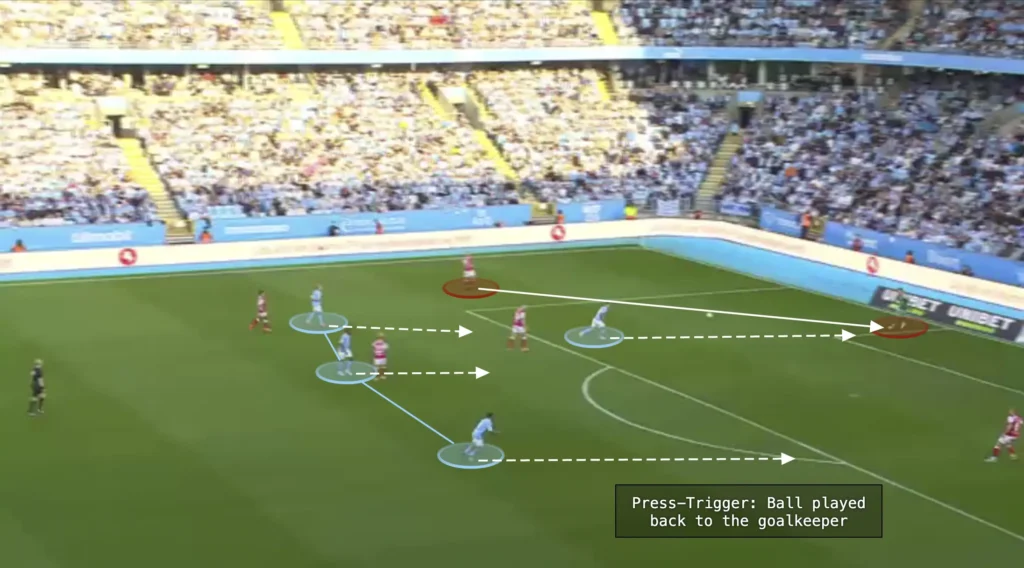
Compactness:
Teams employing high pressing maintain a compact shape to reduce the space available to the opposition. This makes it easier to win back possession and limits passing options for the team in possession.
Here, Pep Guardiola’s Manchester City have forced the opposition(Jacob Neestrup’s FC Copenhagen) to one side of the pitch. The players on the far-side have made sure to push over toward the ball side, looking to preserve a compact pressing shape. This limits the passing options for the opposition, allowing City to win the ball high up the pitch.
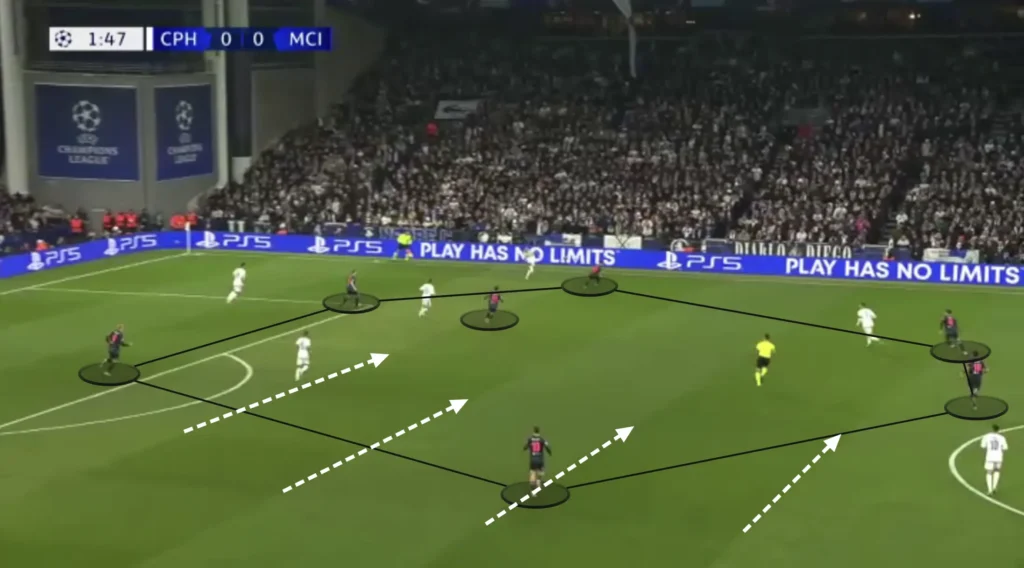
Cover Shadows:
Players use their positioning to block passing lanes while pressing. This forces the opposition to play into less favorable areas, often leading to turnovers.
Here, Jürgen Klopp’s Liverpool are pressing, and the striker breaks out of the shape to put pressure on an opposition center-back. When doing this, he makes sure to close the passing lane to the opposition number-six, stopping the opposition from progressing the ball through the middle.
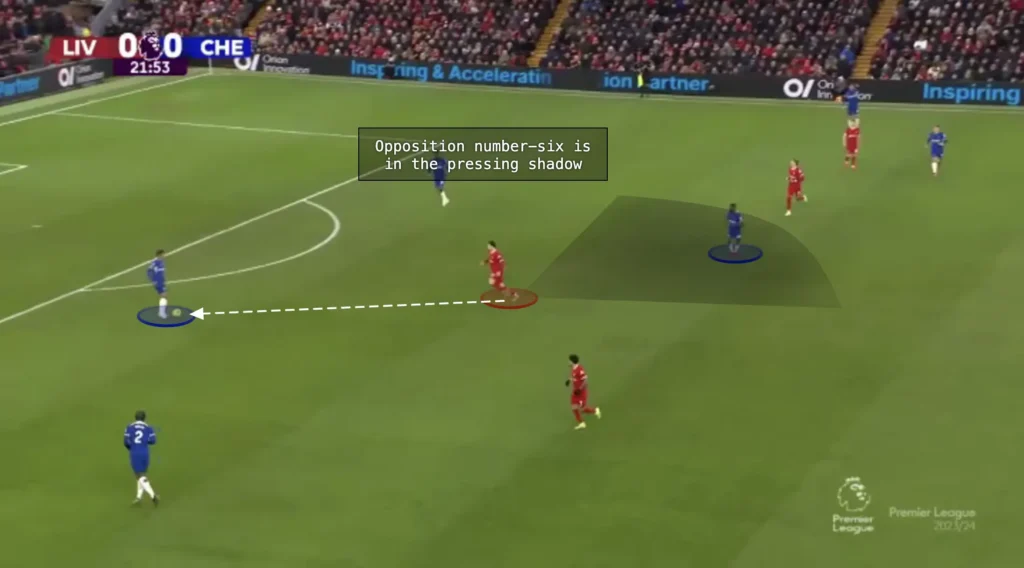
Communication:
Effective high pressing requires constant communication among players. They must coordinate their movements to ensure the press is synchronized and gaps are not left open.
Work Rate:
Work rate is vital for executing an effective high press. Players must maintain relentless effort throughout the game, closing down opponents quickly, tracking runs, and constantly shifting positions to sustain pressure.
High-Pressing Systems
High-pressing systems are structured approaches teams use to implement pressing strategies effectively. Different systems may vary in their setup and focus, but they share a common goal of disrupting the opposition high up the pitch. Below are some common high-pressing systems:
Man-to-Man Pressing:
In this system, each player is assigned an opponent to press. While this ensures close marking, it requires exceptional fitness and awareness to avoid being dragged out of position.
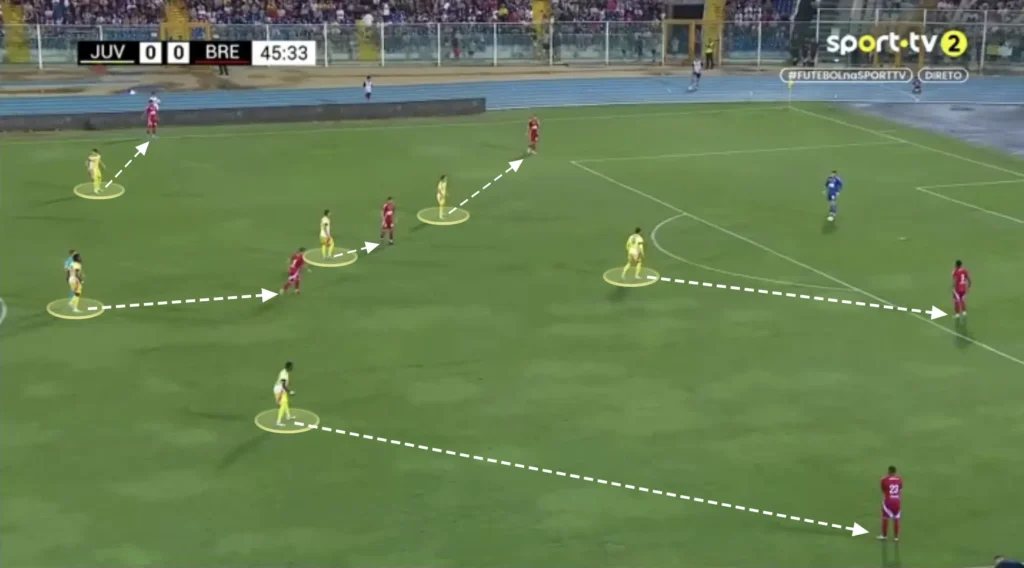
Zonal Pressing:
Players press within designated zones in a high-block rather than marking individual opponents. This method emphasizes collective movement and positional discipline to block passing lanes and suffocate the opposition’s play.
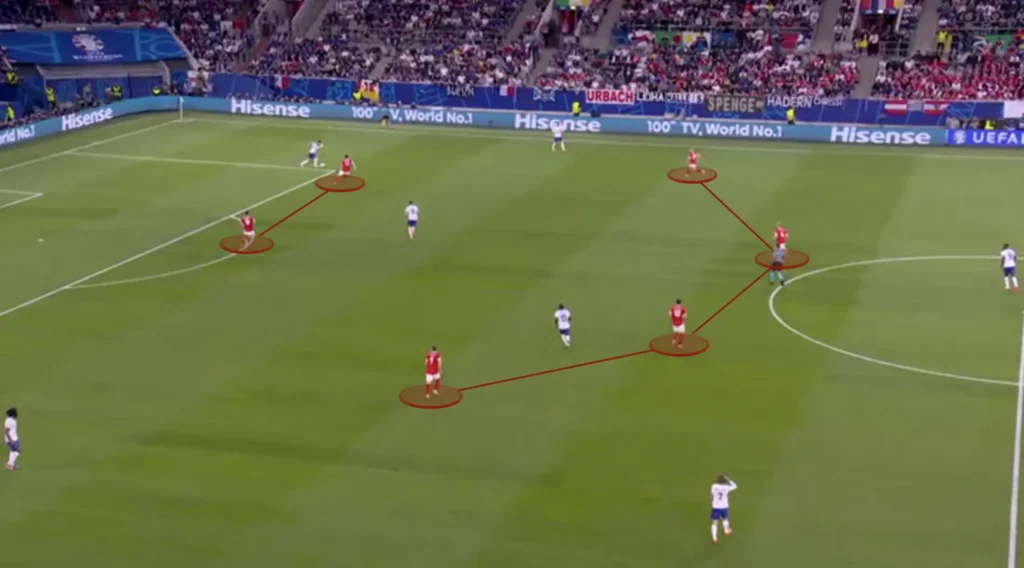
Hybrid Systems:
Many teams employ a combination of man-to-man and zonal pressing, adapting their approach based on the opposition’s strengths and weaknesses. This flexibility allows teams to maintain their shape while targeting specific players or areas.
Here, for example, Artur Jorge’s Botafogo are pressing man-to-man in the midfield, while the front three press zonal, taking care of the opposition players who enter their zone.
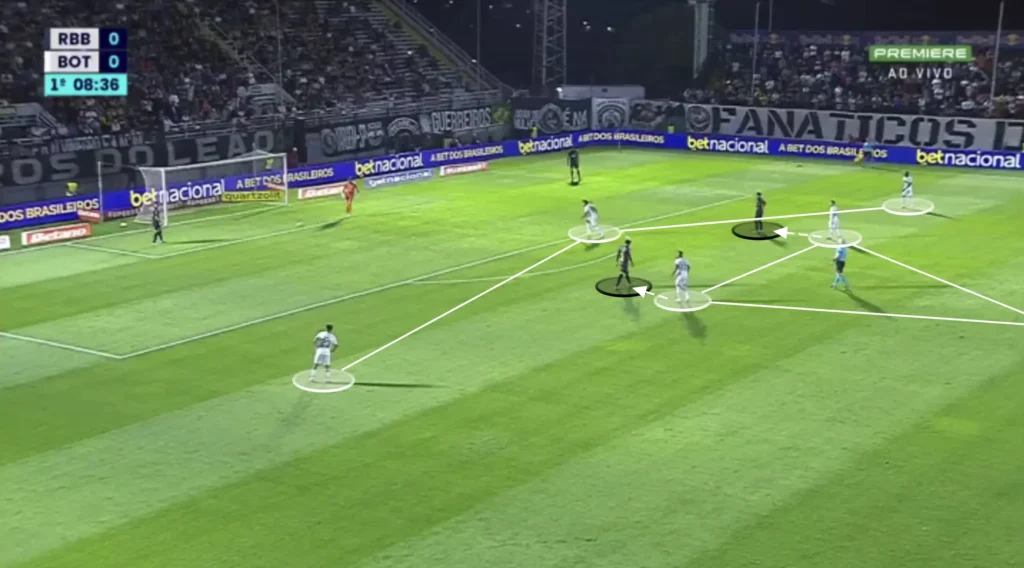
Trap-Based Pressing:
Teams can also set traps by deliberately leaving certain spaces open to lure the opposition into making predictable passes. Once the ball enters these areas, multiple players converge to win back possession.
Advantages of High Pressing
High pressing offers numerous benefits that make it attractive to many coaches:
- Creating Scoring Opportunities:
Winning the ball high up the pitch often means being closer to the opponent’s goal, increasing the likelihood of creating immediate scoring chances. - Disrupting Opposition Play:
High pressing disrupts the rhythm and structure of the opposing team’s build-up, forcing them to play under constant pressure. - Controlling the Tempo:
By regaining possession quickly, teams can dictate the tempo of the game and keep the opposition on the back foot. - Psychological Impact:
A relentless high press can mentally exhaust opponents, leading to mistakes and a loss of confidence over time.
Challenges and Risks of High Pressing
Despite its benefits, high pressing comes with inherent risks and challenges:
- Physical Demands:
High pressing requires exceptional levels of fitness and stamina. Teams that cannot sustain the intensity risk leaving themselves exposed as the game progresses. - Vulnerability to Long Balls:
A high defensive line, often employed in high pressing, can be exploited with well-timed long balls over the top. - Coordination Issues:
If even one player fails to press effectively, it can create gaps in the structure, allowing the opposition to bypass the press and exploit open spaces. - Opponent Adaptation:
Well-prepared opponents can develop strategies to bypass the press, such as using quick one-touch passes or fluid rotations to create confusion and provide additional passing options.
Implementing High Pressing
To successfully implement high pressing, coaches must focus on several key aspects:
- Player Fitness:
A rigorous fitness regime is essential to ensure players can maintain the intensity required for effective pressing. - Tactical Drills:
Regular training sessions should include pressing drills that simulate match scenarios, helping players understand when and how to press. - Positional Awareness:
Players must be aware of their roles and responsibilities within the pressing structure, ensuring they cover spaces and maintain compactness. - Video Analysis:
Analyzing opposition tendencies can help identify pressing triggers and potential weaknesses to exploit during matches. - Squad Depth:
Rotating players and managing fatigue is crucial, as a high-pressing style can take a toll on the squad over the course of a season.
Conclusion
High pressing is a hallmark of modern football, showcasing the blend of athleticism, intelligence, and teamwork required to succeed at the highest level. While it comes with challenges, its ability to disrupt opponents and create scoring opportunities makes it a powerful tactical weapon. By understanding the principles, advantages, and risks associated with this aggressive strategy, teams can use this strategy to dominate games and outsmart their opponents. Whether you’re a coach, player, or fan, studying high pressing offers valuable insights into the evolving world of football tactics.

Hello. Thanks for your great article!
I’ve translated it to persian and wrote the main source:
https://zoomsportfa.ir/news/11959/
Please continue writing such articles.